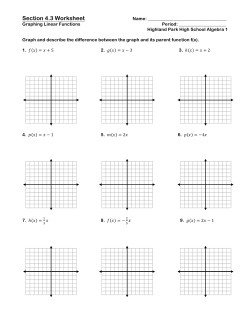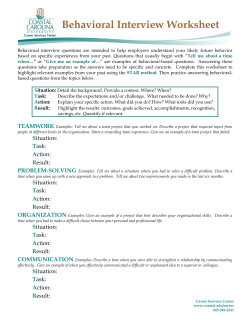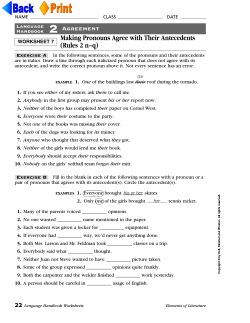
Worksheet #10: Probability Review
Worksheet #10: Probability Review Probability Formulas: 1. Combinations (order does not matter): n Cr 2. Permutations (order matters): n Pr n! (Use your calculator!) n r ! n! (Use your calculator!) n r ! r ! 3. Unions (“or”): P A B P A P B P A B For independent events, this simplifies to P A B P A P B P A P B For mutually exclusive (disjoint) events, this simplifies to: P A B P A P B 4. Intersections (joint probability – “and”): P A B P A P B A For independent events, this simplifies to P A B P A P B For mutually exclusive (disjoint) events: P A B 0 5. Conditional probability: P B A P B A P A Probability Tips: I. General Probability 1. What are independent events? Events that do not affect the outcomes of each other. 2. Two ways to prove independence P A B P A P B P B A P B 3. What are dependent events? Mutually exclusive/disjoint events are a special case of dependent events – THESE ARE NOT INDEPENDENT! Independent events must have an intersection, while disjoint events cannot have an intersection. How do you find the intersection of dependent events? From a two-way table or a tree diagram (or it is given). p(int) 4. Conditional probability = p(cond ) 5. Tree diagrams are the most convenient way of dealing with multi-stage probability Remember that the second set of branches represent conditional probabilities. Remember that multiplying across the branches gives the intersection of events … this is the same as using the general multiplication rule – for all events! – which is P A B P A P B A . Worksheet #10: Probability Review II. Random Variables 1. Discrete random variables are produced by events with countable outcomes (ex: rolling two dice) The probability distribution for a DRV is a probability histogram. The mean of a discrete random variable is called the expected value. Review Problems 1. Expand the following binomial: (a) w 2 5 (b) 2x 4 5 2. Find the specified nth term in the expansion of the binomial: 2x 3 y ; n 5 8 3. Find the coefficient a of the term in the expansion of the binomial. Binomial Term 2x 5 y 7 ax 2 y5 4. A local restaurant serves five appetizers, four types of salad, three types of soup, five entrées, and six desserts. The restaurant offers a special meal where a family or group may select two appetizers, two types of salad, one type of soup, one entrée, and three desserts. How many different meals could be created from the restaurant’s offerings? 5. A family has four children, all attending four different prestigious universities. Each child has sent their parents two different car magnets with the child’s university’s names on them (8 total car magnets). If the parents wish to advertise the brilliance of their children on the back of their BMW, how many different arrangements of car magnets are possible if there is room for exactly four magnets (and they don’t mind advertising the same university more than once)? 6. Walton’s National Honor Society has decided to streamline their process for admission and has decided to take the top 10 students from the sophomore and junior class (20 total students) and randomly select a group of 8 of them for membership. How many different groups of 8 students could be chosen? Worksheet #10: Probability Review 7. An athlete suspected of using steroids is given two tests that operate independently of each other. Test A has probability 0.9 of being positive if steroids have been used. Test B has probability 0.8 of being positive if steroids have been used. What is the probability that neither test is positive if steroids have been used? (a) 0.72 (b) 0.38 (c) 0.02 (d) 0.28 (e) 0.08 8. An instant lottery game gives you probability 0.02 of winning on any one play. Plays are independent of each other. If you play 3 times, the probability that you win on none of your plays is about (a) 0.98. (b) 0.94. (c) 0.000008. (d) 0.06. (e) 0.96. 9. The probability that you win on one or more of your 3 plays of the game in the previous question is about (a) 0.06. (b) 0.02. (c) 0.999992. (d) 0.04. (e) 0.98. 10. Choose an American adult at random. The probability that you choose a woman is 0.52. The probability that the person you choose has never married is 0.24. The probability that you choose a woman who has never married is 0.11. The probability that the person you choose is either a woman or never married (or both) is therefore about (a) 0.76. (b) 0.65. (c) 0.12. (d) 0.87. (e) 0.39. 11. Of people who died in the United States in a recent year, 86% were white, 12% were black, and 2% were Asian. (This ignores a small number of deaths among other races.) Diabetes caused 2.8% of deaths among whites, 4.4% among blacks, and 3.5% among Asians. The probability that a randomly chosen death is white and died of diabetes is about (a) 0.107 (b) 0.030. (c) 0.024. (d) 0.86. (e) 0.03784. 12. Using the information in the previous question, the probability that a randomly chosen death was due to diabetes is about (a) 0.107. (b) 0.038. (c) 0.024. (d) 0.96. (e) 0.030. Worksheet #10: Probability Review 13. Event A occurs with probability 0.2. Event B occurs with probability 0.8. If A and B are disjoint (mutually exclusive), then (a) P(A and B) = 0.16. (d) P(A or B) = 0.16. (b) P(A or B) = 1.0. (c) P(A and B) = 1.0. (e) both (a) and (b) are true. 14. A fair coin is tossed four times, and each time the coin lands heads up. If the coin is then tossed 1996 more times, how many heads are most likely to appear for these 1996 additional tosses? (a) 996 (b) 998 (c) 1000 (d) 1996 (e) None of the above. 15. If you buy one ticket in the Provincial Lottery, then the probability that you will win a prize is 0.11. If you buy one ticket each month for five months, what is the probability that you will win at least one prize? (a) 0.55 (b) 0.50 (c) 0.44 (d) 0.45 (e) 0.56 16. An insurance company has estimated the following cost probabilities for the next year on a particular model of car: Cost Probability $0 0.60 $500 0.05 $1000 0.13 $2000 ? The expected cost to the insurance company is (approximately) (a) $155. (b) $595. (c) $875. (d) $645. (e) $495. 17. Suppose we have a loaded die that gives the outcomes 1 to 6 according to the probability distribution X 1 2 3 4 5 6_ P(X) 0.1 0.2 0.3 0.2 0.1 0.1 Note that for this die all outcomes are not equally likely, as would be if this die were fair. If this die is rolled 6000 times, then x , the sample mean of the number of spots on the 6000 rolls, should be about (a) 3. (b) 3.30. (c) 3.50. (d) 4.50. (e) 3.25. Worksheet #10: Probability Review 18. If a player rolls two dice and gets a sum of 2 or 12, he wins $20. If the person gets a 7, he wins $5. The cost to play the game is $3. Find the expected win/loss of the game. 19. Here is the assignment of probabilities that describes the age (in years) and the sex of a randomly selected American student. Age Male Female 14-17 0.01 0.01 18-24 0.30 0.30 25-34 0.12 0.13 ≥35 0.04 0.09 (a) What is the probability that the student is a female? (b) What is the conditional probability that the student is a female, given that the student is at least 35 years old? (c) What is the probability that the student is either a female or at least 35 years old? 20. If three dice are rolled, find the probability of getting triples (that is, 1,1,1 or 2,2,2 or 3,3,3, etc.). 21. If four cards are drawn from a standard deck of 52 playing cards and not replaced, find the probability of getting at least one heart. 22. A box contains ten $1 bills, five $2 bills, three $5 bills, one $10 bill, and one $100 bill. A person is charged $20 to select one bill. (a) Identify the random variable. X = (b) Construct a probability distribution (histogram) for these data. (c) Find the expected value. Worksheet #10: Probability Review (d) Is the game fair? Explain briefly. 23. Suppose that for a group of consumers, the probability of eating pretzels is 0.75 and that the probability of drinking Coke is 0.65. Further suppose that the probability of eating pretzels and drinking Coke is 0.55. Determine if these two events are independent.
© Copyright 2025
















